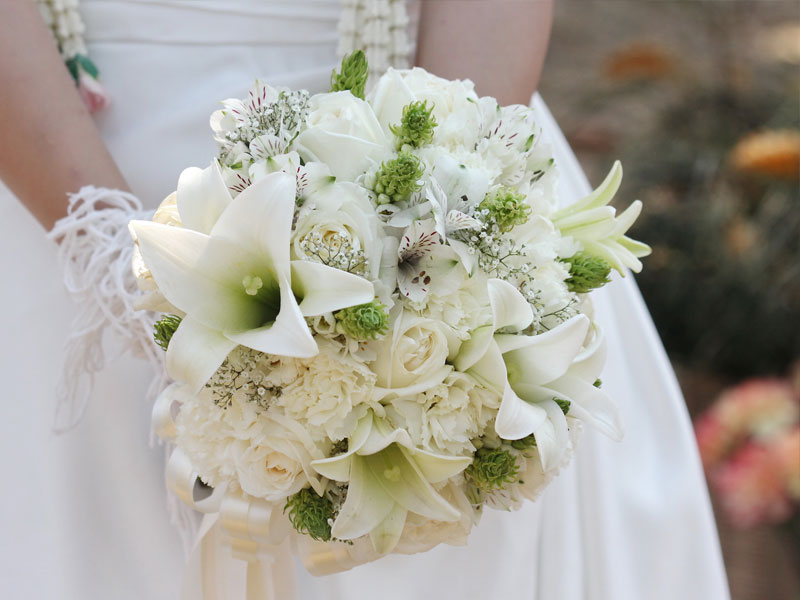Bridal Flowers
Article originally published in the San Francisco Nob Hill Gazette

June without flowers would be like weddings without brides or bouquets. Seasonally, 35 percent of weddings take place in summer when flowers are in riotous abundance. These lovely adornments of nature create an ambiance and mood so necessary at a wedding. First impressions relate to color and there are six million detectable to the human eye. One of the most costly items in the nuptial budget, today’s flowers offer an ever-expanding array of type, color, size, shape, texture and strength of fragrance.
To fend off evil spirits, ancient Egyptians used strong smelling herbs and flowers in a bride’s bouquet. Today, this superstition carries on through the use of sweet-smelling flowers. The bouquet maybe a cascade (resembling a waterfall), colonial, teardrop, crescent, nosegay/posy, (a small fragrant bouquet) or a single flower. Then there are bouquets for the bridesmaids, boutonnieres for the groom and male attendants, corsages, ceremony, reception and centerpiece flowers, and of course, a going-away corsage for the bride.
Flowers can show up on the cake knife and in water goblets. A single rose can mark the seats for the mother of the bride and groom. Rose petals can be sprinkled on the cake table, on walkways, and be tossed instead of rice.
The Society of American Florists and the American Institute of Floral Designers note three popular bridal trends: Royal Garden. Romantic Sophistication, and Contemporary Chic.
- The Royal Garden may be an intricate summer pavilion with stone urns on pedestals, and a garden trellis woven with flowers or flowering vines. The bridal bouquet may combine regal and fragrant Casablanca lilies with astilbe and peonies tied with a French-braided ribbon.
- Romantic Sophistication places silver candelabras entwined with foliage on circular tables. A Victorian style wedding utilizes soft colors, and flowers may be placed in the bride’s hair as well as in the bouquet.
- The Contemporary Chic bouquet may consist of pure calla lilies as it’s main element, surprisingly highlighted with freesia and accented with lily grass. A particular color can be linked to an era. There’s Reagan red of the ‘80s, harvest gold and avacado green of the ‘70s and Kingfisher blue of the ‘50s. With the emergence of bolder lifestyles, deep floral colors such as bright yellows, intense violets, rich reds and bright blues are rising in popularity.
Considering his work an art form, event planner Stanlee Gatti, whose risk-taking imagination has landed him an empire, boasts no boundaries. He interprets client’s feelings, and amid their trust, he adventures through lavish, often dramatic and innovative designs. One example is the creation of the “sculpted” or layered arrangement, which may involve various flowers.
For a Dunsmuir House wedding, he built a topiary maze and rose garden. On another occasion, he completely transformed a tennis court into a country garden, incorporating a pergola covered with lemon leaves and 30,000 lemons. For yet another, he created a hedge of one-half million French tulips.
Since Gatti’s clients are just as surprised with the end result as their guests (there are no drawings), we asked if any of his wedding projects had been close to disaster. He recounted the “Orange Wedding” story of several years ago. At that time orange was neither used nor fashionable. Upon meeting his client, Gatti was given, as he usually is, carte blanche to do anything he wanted within budget. He saw orange and lots of it and decided to take the risk with orange parrot tulips, branches with oranges, and orange plates. Three days before the wedding, the client learned of this theme and reminded him that she’d given him rein to do anything but use the color orange. Apparently, Gatt’s inspiration outshone his memory. Although he would’ve changed everything for her satisfaction, she decided to go with it and loved it. This exhilarating experience must have motivated her into wanting to stay indelibly connected, for orange now accents her home. Thus, the answer to that question about ever having a disaster, was that he almost did – but no.
Good designers respond to the personalities of their clients and of course must work with floral availability. Trends are branching away from the traditional, and some florists eliminate roses entirely. Usually, the first wedding is traditional.
“It’s the mother’s wedding.” says event designer Robert Fountain. “The second wedding comes out of the box and can be more creative.”Fusion of styles is popular. Fountain plays with what he terms “Floral Architecture” and likes to create settings where flowers appear to be growing together. Never taking a cookie cutter approach, and sometimes needing research, Fountain has produced Medieval, Scottish, and even 1920s Art Deco events, for example, but they’re tastefully styled and not a “trip into Disneyland.”
“People will always love flowers,” says Fountain, “but they should never be used in excess or take over an event.” He predicts a more minimal use of flowers, as event planners continue to design whole environments. But his last words were, “Don’t skimp on the flowers. It will show in the pictures. You have those for the rest of your life.”
“People will always love flowers,” says Fountain, “but they should never be used in excess or take over an event.” He predicts a more minimal use of flowers, as event planners continue to design whole environments. But his last words were, “Don’t skimp on the flowers. It will show in the pictures. You have those for the rest of your life.”
In conclusion, it seems there’s more freedom than ever to explore the folds of imagination, set trends and hope that they’re in good taste. Flowers will always be a fundamental part of the wedding ceremony, and with all due respect to the groom, what is most captured and remembered is that first glance at the beaming bride with her bouquet.
